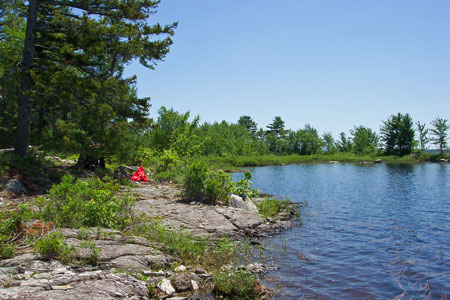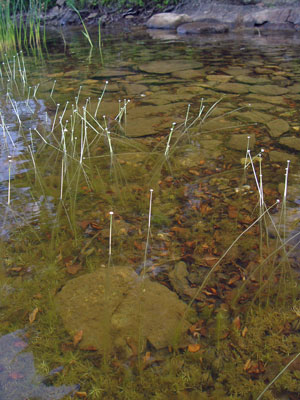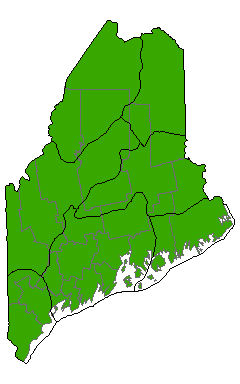DACF Home → Bureaus & Programs → Maine Natural Areas Program → Communities, Plants, and Animals → Natural Community Fact Sheets → Sandy Lake - Bottom
Printer Friendly Fact Sheet - 1.1 MB pdf (Get a free copy of Adobe Acrobat Reader)
Sandy Lake - Bottom
Scientific Name: Pipewort - Water Lobelia Aquatic Bed; State Rank: S5

- Community Description
- Soil and Site Characteristics
- Diagnostics
- Similar Types
- Conservation, Wildlife and Management Considerations
- Distribution
- Characteristic Plants
- Associated Rare Plants
- Associated Rare Animals
- Examples on Conservation Lands You Can Visit
Community Description: In this shallow water vegetation type, almost all of the plant growth is underwater with only the flowering portions of the plants above water. The most typical species, pipewort and water lobelia, grow as rosettes on the substrate below the water surface. Associated species may be rosette plants or submerged plants growing in the water column (e.g., leafless water-milfoil). Water-shield, a plant with leaves that float on the surface, may be abundant in patches. Water-lilies and pickerelweed may be present but at low cover. Vegetation cover ranges from sparse to extensive. Back to top.

Soil and Site Characteristics: This community type can be found in quiet waters of lakes, ponds, streams, and rivers; sites are usually shallow (depths 0.2-1.1 m). The lake bottom substrate almost always has a predominant mineral soil component rather than muck. Back to top.
Diagnostics: The most abundant species are those that grow as rosettes on the bottom, especially pipewort and water lobelia. Floating leaved plants are absent or very low in cover. Back to top.
Similar Types: Open-water Marsh vegetation and Pickerelweed Marsh vegetation can share many species with this type, but these community types are dominated by floating leaved plants or emergent plants, respectively. Back to top.
Conservation, Wildlife and Management Considerations: This aquatic community type is widespread in Maine. It can be found in the quieter portions of streams and rivers as well as in lakeshores and pondshores. It provides habitat for a variety of water-dependent animals. Many examples occur on public lands and private conservation lands; however, because the type is so common it is not always documented. The major threats to this community are water quality degradation from excess nutrients, damage from boat wakes, and the spread of invasive aquatic plants, such as Eurasian water-milfoil and variable water-milfoil.
These aquatic beds, especially where they contain floating-leaved plants like water-shield, may provide habitat for damselflies such as the rare scarlet bluet, which seems to prefer acidic sandy-bottomed habitats with water-shield and rushes. Alkaline ponds with aquatic vegetation may support many of the same wildlife species found in more acidic aquatic communities such as Water-lily Macrophyte Aquatic Bed or Pickerelweed - Macrophyte Aquatic Bed. It is unclear whether any wildlife species prefer the more alkaline conditions that this community provides. Back to top.
Distribution: Statewide; extending southward and westward from Maine, and presumbably into Canada. Landscape Pattern: Small Patch, linear. Back to top.


Characteristic Plants: These plants are frequently found in this community type. Those with an asterisk are often diagnostic of this community.
- Herb
- Creeping spearwort
- Pipewort*
- Water lobelia*
- Water-shield*
- Scarlet bluet
Examples on Conservation Lands You Can Visit
| Example | County |
|---|---|
| Chemo Pond, Penobscot Experimental Forest | Penobscot Co. |
| Kidney Pond, Baxter State Park | Piscataquis Co. |
| Pepperpot Pond, Richardson Lake Public Lands | Oxford Co. |
| Range Ponds State Park | Androscoggin Co. |